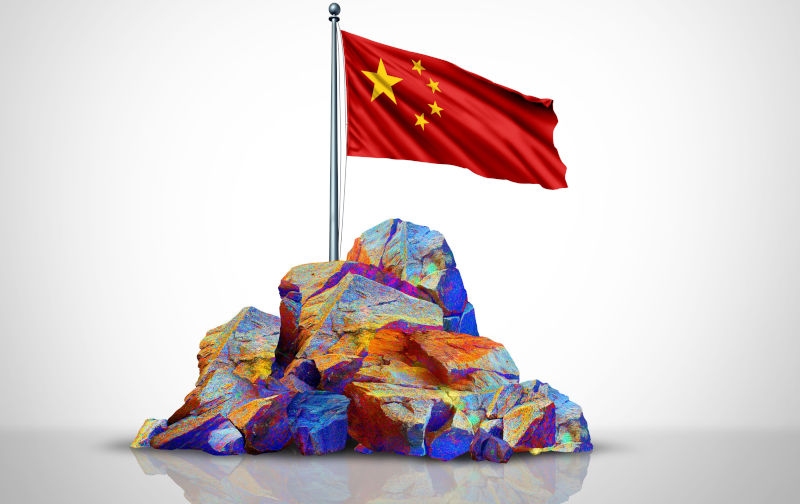China’s critical minerals chokehold sparks Quad action
August 25, 2025
The global production of advanced technologies — from smartphones and electric vehicles to renewable energy and military systems — relies on rare earth elements such as neodymium and dysprosium, essential for permanent magnets.
As of early 2025, more than 90% of the world’s processing capacity for rare earth magnets remains concentrated in China, creating a pressing vulnerability in global supply chains.
China’s rare earths chokehold has triggered not just a supply crisis, but a strategic awakening, forcing democracies like those in the Quad — Australia, India, Japan and the US — to rewire their mineral dependencies, industrial strategies and geopolitical alignments.
The issue escalated significantly in early 2025, following the re-election of US President Donald Trump and the subsequent imposition of sweeping tariffs on Chinese imports. In response, Beijing announced curbs on the export of rare earths and related magnet components. Immediately, global shipments of rare earth magnets fell to multi-year lows and production lines across the automotive, aerospace and electronics sectors experienced severe disruptions. From windshield wiper motors to electric vehicle powertrains, critical components were suddenly at risk.
In response to growing industrial strain, Washington and Beijing initiated talks aimed at stabilising trade flows. By late June 2025, both sides unveiled a limited framework designed to alleviate immediate pressures. But any semblance of stability proved short-lived. Chinese officials disclosed that export licences had been issued only on a limited basis, with each permit valid for just six months. Concurrently, reports emerged of magnet stockpiling within China’s Baotou rare earth hub, raising concerns about future availability and signalling Beijing’s continued leverage over global supply chains, even under conditions of diplomatic detente. These restrictions have pushed India’s IREL to pursue rare earth magnet partnerships with Japan and South Korea as of August 2025.
While these developments received limited media attention, their implications are far-reaching. Temporary curbs on exports led to production halts at multiple European automotive plants, exposing the fragility of high-tech manufacturing ecosystems. Crucially, this is not solely a commercial issue – it represents a latent threat to national security. Without secure access to critical minerals, Western defence industries risk cost escalations, procurement delays and degradation of core capabilities.
Amid these disruptions, the Quad adopted a more co-ordinated stance. In July 2025, foreign ministers met in Washington and launched the Quad Critical Minerals Initiative, a collective effort aimed at reducing strategic vulnerabilities in mineral supply chains. Their joint statement acknowledged that over-dependence on any single country posed risks of coercion, price manipulation and supply insecurity. The initiative seeks to fund joint investments in mining, processing and stockpiling, with a focus on politically stable and partner-aligned jurisdictions.
Initial indications suggest the initiative is gaining traction. Japan has expanded its lithium co-operation with Australia, and India has expedited its domestic mineral approval processes and signed new bilateral supply agreements with partners in Africa and Central Asia. In Brussels, the European Parliament has increasingly echoed Quad concerns, calling for greater alignment in mineral policy.
Industry actors are also adapting. Japanese automakers are exploring cobalt reserves in Queensland, US and Australian firms are initiating rare earth projects in Africa, and Indian companies are enhancing both overseas partnerships and domestic refining capacity. These developments point to an incipient restructuring of global industrial logic away from single-node dependence and towards diversified, resilient supply ecosystems.
Still, the path to fully realising the Quad’s ambitions is likely to encounter structural and political obstacles. Divergent regulatory standards, environmental compliance timelines and capacity gaps among member states may slow progress. Each Quad member brings distinct geopolitical considerations. India, for instance, continues to balance diversification imperatives with its longstanding commitment to strategic autonomy.
The capital-intensive nature of mining and refining projects, particularly in frontier markets, also poses financing challenges. Addressing these hurdles will require sustained public-private co-ordination, trust-building mechanisms and frameworks that ensure policy continuity across political cycles. Success will depend on whether the Quad can translate shared intent into coherent and enduring institutional architecture.
What was previously viewed as an inconvenient dependence on China is now recognised as a strategic liability. The focus has shifted from reactive supply protection to proactive industrial sovereignty and geopolitical flexibility. This transformation underscores a deeper structural lesson: that technological capacity is inseparable from material security.
The sudden scarcity of rare earths has revealed the extent to which global innovation is contingent on unbalanced access to critical inputs. The Quad’s mineral initiative, though not widely publicised, marks a significant step towards structural co-operation among democratic states. If effectively implemented, it could underpin long-term economic stability and technological leadership across the Indo-Pacific and beyond.
Securing the supply chains of critical technologies requires more than just market mechanisms. It demands co-ordinated policy, cross-border investment and institutional trust. The coming decade will test whether democratic coalitions can extend their co-operation beyond shared values to the material foundations of power. Rare earths may prove not only to be vital commodities but defining instruments of strategic resilience.
Republished from East Asia Forum, 21 August 2025
The views expressed in this article may or may not reflect those of Pearls and Irritations.
